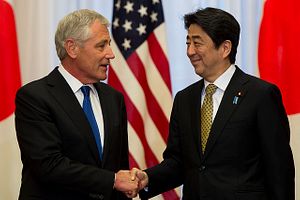On July 1, the Japanese Cabinet issued an eight page document detailing a set of changes in the way Japan approaches its defense and security policy. At first glance the decision seems minor, almost a technicality, but it represents one of the biggest changes in Japan’s defense and security policy since the Second World War.
Although Japan has one of the world’s largest defense budgets and a highly sophisticated military, the circumstances under which it can use force are unusually circumscribed. The postwar Constitution, hastily written by the Americans and imposed upon Japan as part of the WWII peace settlement, expressly forbids the use of military power as a tool of statecraft. Over time the Constitutional constraint was eased, allowing Japan to have a defense force but one that had only one purpose: the defense of Japan from attack. Under no other circumstance were the Self-Defense Forces (SDF) allowed to use their muscle: not to help Japan’s ally the United States, not as part of UN operations, not even if Japan came under attack while participating in post-conflict situations.
The Cabinet decision widens the range of circumstances under which the SDF can operate. It did so in the politically more straightforward way of changing interpretations of the text rather than trying to change the Constitution itself. The new interpretation continues to impose much greater constraints on Japan’s military than any other state faces. But once domestic legislation is passed, the SDF will be able to come to the aid of a partner state that is under attack in circumstances that can be construed as having significant consequences for Japan. The SDF can now fight beyond Japan’s borders. It is not a blank check: force must be the last resort and at the minimum level necessary to have the desired effect. Nonetheless, Japan can now be a more equal partner with the U.S. and others and it can begin to think about the role it plays in the region in a very different way than in the past.
There is a temptation both to over- and understate the significance of this change. China’s state-run news media have fulminated in typical fashion about the revival of Japanese militarism. And even South Korea is uneasy about just what this move might entail. To be clear, under only the most casuistic reading can this be seen as paving the way to 1935. Yet it is also wrong to think this is just a slight change at the margins of Japanese defense policy, a thing only of concern to policy wonks and the military equivalent of train-spotters.
The SDF will now need to begin to restructure its doctrine, operations, and force acquisition programs to reflect this new task. Indeed one may speculate on the extent to which it might receive a name change to become the JDF, as its mission now is about more than self defense. This will have regional consequences as Japan’s ability to project force abroad grows. At a basic level, it will make Asia a more uncertain place because of the way it is likely to contribute to increased military expenditure in the region and will almost certainly further exacerbate Sino-Japanese tensions.
The U.S. has long sought to have Japan in a position to do more to support Washington’s vision for Asia. Now it can begin to do so. While it will be some time before Japan’s maritime forces are patrolling the Western Pacific with their American allies, the way in which the alliance operates in Northeast Asia can begin to change given the functions that Japan’s forces can now provide. By being the dominant power in Asia, the U.S. has been seen as playing a stabilizing role in the region by preventing competitive military dynamics from coming to the surface. American dominance meant China was restrained from using force to take Taiwan, North Korea was prevented from attacking the South, and all players were dissuaded from engaging in arms races, particularly those caused by Japanese military development. Not everyone liked it, but it was a situation with which all could live. The key to its political and strategic acceptability was that it was the U.S. alone exerting power. Now, American power is to have the modest but active support of Japan. As a result the political color of the regional order will change, and change in ways with which many will not be content.
Abe’s government, encouraged by Washington and others, has embarked on a journey that will profoundly change the region. The most important challenge for Asia’s states is to recognize the extent to which the status quo is being transformed and to realize the political implications of this move so that work can begin to manage the transition to a new order. A conflict-prone and dangerous fate is not inevitable for Asia, but it will be if we are complacent about the nature and scale of the change that Japan’s Constitutional reinterpretation will bring about.
Nick Bisley is Executive Director of La Trobe Asia and Professor of International Relations at La Trobe University, Melbourne, Australia

































